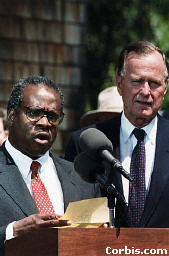|
The Politics of Judicial Nominations |
|
ANNOUNCEMENT: CLASS TUESDAY WILL BE SLIGHTLY SHORTENED SINCE I HAVE TO BE IN MANHATTAN BY 5PM; IT WILL ALSO HAVE A SLIGHTLY EARLIER STARTING TIME. SO, WE'LL BE MEETING FROM 3.15-4.00pm. |

Ronald Reagan nominating Robert Bork for a Supreme Court vacancy, 1987
| Given the increasing links between law and politics, there is little surprise that the ultimate point of intersection between the two phenomena--Supreme Court appointments--has grown more controversial. Since 1968, six Supreme Court nominees (Abe Fortas, Homer Thornberry, Clement Haynsworth, G. Harrold Carswell, Robert Bork, and Clarence Thomas) have faced divisive confirmation fights; only Thomas ultimately received Senate approval. |
| As we talked about in class Thursday, Haynsworth and Carswell fights can be discussed as part of Richard Nixon's "Southern Strategy," in which the President promised to appoint "strict constructionists" to the Court. Carswell was perhaps the least qualified person nominated in the 20th century to the Court; during Senate debate over his confirmation, his chief defender, Senator Roman Hruska (R-Nebraska) attempted to turn Carswell's perceived mediocrity into an asset. "Even if he is mediocre," Hruska said, "there are a lot of mediocre judges and lawyers. They are entitled to a little representation, aren't they, and a little chance? We can't have all Brandeises, Cardozos, and Frankfurters, and stuff like that there." |
| But this issue became much more prominent in the 1980s and early 1990s. In a way, the Bork and Thomas confirmation battles were forerunners of the 1990s "trials of the century"--OJ Simpson, Rodney King, and others--in which the judicial arena became the setting for a broader social commentary on important issues in American life. In the case of Bork, abortion and civil rights were the key issues; the Thomas confirmation was dominated by the vagaries of racial politics and the boundaries of sexual harassment. With the Democrats possessing a 14-seat majority in the Senate, a determined grassroots campaign by women's groups and especially civil rights activists--along with Bork's many writings, in which he attacked, among other things, the constitutionality of Roe and the 1964 Civil Rights Act--helped send the nominee down to defeat by an overwhelming 58-to-42 vote. The less conservative Anthony Kennedy ultimately replaced Bork as President Reagan's selection. |
| In many ways, the Thomas battle contained more long-term importance than the Bork fight. President George Bush's first nominee was the moderate David Souter. But Thomas, who had compiled a strongly conservative record on the bench and in working as Ronald Reagan's director of EEOC, was nominated to replace the Court's most liberal member, the gravely ill Thurgood Marshall. Although Bush claimed that Thomas was selected because "he is the best person for this position," Thomas's status as an African-American conservative clearly entered into the equation. |

President Bush introducing Judge Thomas |
| From September 10 through 20, 1991, the Senate Judiciary Committee conducted intensive hearings that focused on Thomas's rather slim qualifications and conservative views; Thomas himself testified for five days, while a variety of liberal groups spoke in opposition. On September 27, the Judiciary Committee voted 7 to 7 on Thomas's nomination, thus sending the issue to the full Senate without the committee's endorsement. | |

Anita Hill before the Senate Judiciary Committee |
Before that vote could be scheduled, however, National Public Radio's Nina Totenberg broke the story that a former assistant to Thomas, University of Oklahoma law professor Anita Hill, had charged that Thomas had sexually harassed her. On October 11, the Judiciary Committee re-opened the hearings, inviting testimony from Hill and Thomas. Public opinion nationwide was divided over which person to believe: Thomas described the affair as a "high-tech lynching" of an "uppity black" who thought for himself, while Hill's supporters cringed at the harsh questions she received from an all-white, all-male committee. On October 15, the full Senate began debate on the nomination; the next day, by a 52 to 48 margin, the upper chamber voted to confirm Thomas as an associate justice of the Supreme Court. |
| Aftermath: |
| The hearings left a polarized country in their wake. The media came under strong--and, in many ways, justified--attack for its handling of the affair. More important, the Senate's response to Hill galvanized women's political groups, who had suffered a series of setbacks during the Reagan years. In Illinois, Cook County Clerk Carol Mosely-Braun challenged incumbent Democratic senator Alan Dixon after Dixon voted for Thomas; in a stunning upset, Moseley-Braun captured the Democratic nomination and became the first African-American woman ever elected to the Senate. In Washington, a little-known state senator, Patty Murray, defeated a former congressman in the Democratic primary and a sitting congressman in the genera election to become the first woman senator from her state. And in California, which had two open Senate seats, Democrats Barbara Boxer--a graduate of Brooklyn College--and Dianne Feinstein swept to victory in the fall. Their election, combined with the public reaction to the hearings, brought renewed attention to the issue of sexual harassment in Washington, and Congress in the early 1990s passed several pieces of legislation strengthening sexual harassment laws. |